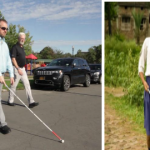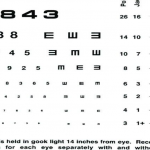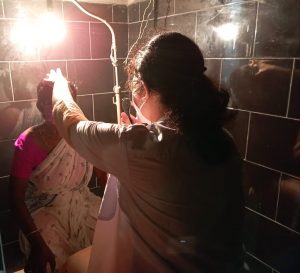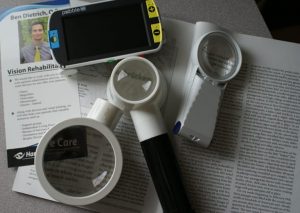Vision rehabilitation (often called vision rehab) is a term for a medical rehabilitation to improve vision or low vision. In other words, it is the process of restoring functional ability and improving quality of life and independence in an individual who has lost visual function through illness or injury. Most visual rehabilitation services are focused on low vision, which is a visual impairment that cannot be fully corrected by regular eyeglasses, contact lenses, medication, or surgery.
Definition: Rehabilitation (literally, the act of making able again) helps patients achieve physical, social, emotional, spiritual independence and quality of life. Rehabilitation does not undo or reverse the cause of damage; it seeks to promote function and independence through adaptation. Individuals can seek rehabilitation in different domains, such as motor rehabilitation after a stroke or physical rehabilitation after a car accident. Low vision can be caused by many diseases.
Who needs vision rehabilitation ?
Vision rehabilitation Useful for patients with macular degeneration, cataracts, glaucoma, diabetic retinopathy,retinitis pigmentosa,retinal detachment, retinopathy of prematuarity or visual field loss. Patients with low visual acuity (<20/50), central or peripheral vision loss, reduced contrast sensitivity, glare, and light/dark adaptation difficulties may benefit.
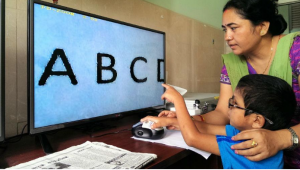
Types of Visual Impairment that can Benefit from Vision Rehabilitation
Low vision affects people at school, on the job, and at home. It makes daily activities like writing, reading, watching television, and walking difficult.
Symptoms of low vision
Blurred vision Objects appear out of focus. Causes include macular degeneration, diabetes, corneal disease, and cataracts.
Central field lossA darker hazy patch appears in the center of objects. Causes include macular degeneration, and optic atrophy.
Contrast loss and glare problemsObjects blend with background: lights are distracting or uncomfortable. Causes include glaucoma, cataracts, corneal disease, and albinism.
Multiple field loss Dark patches are scattered around objects. Causes include diabetes, glaucoma, retinal detachment, and trauma.
Distortion Objects appear out of shape, crooked, deformed, wavy, or doubled. Causes include macular degeneration, diabetes, and retinal detachment.
Tunnel vision Objects in the center of the field of vision are visible: objects on the sides are missing. Causes include glaucoma, retinitis pigmentosa, and stroke.
VISION REHABILITATION THERAPY OR TREATMENT
Neurological approach
There are many treatments and therapies to slow degradation of vision loss or improve the vision using neurological approaches. Studies have found that low vision can be restored to good vision.In some cases, vision cannot be restored to normal levels but progressive visual loss can be stopped through interventions.
Chemical treatments
In general, chemical treatments are designed to slow the process of vision loss. Some research is done with neuroprotective treatment that will slow the progression of vision loss.Despite other approaches existing, neuroprotective treatments seem to be most common among all chemical treatments.
Gene therapy
Gene therapy uses DNA as a delivery system to treat visual impairments. In this approach, DNA is modified through a viral vector, and then cells related to vision cease translating faulty proteins.[9] Gene therapy seems to be the most prominent field that might be able to restore vision through therapy. However, research indicates gene therapy may worsen symptoms, cause them to last longer or lead to further complications.
Physical approach
For physical approaches to vision rehabilitation, most of the training is focused on ways to make environments easier to deal with for those with low vision. Occupational therapy is commonly suggested for these patients. Also, there are devices that help patients achieve higher standards of living. These include video magnifiers, peripheral prism glasses, transcranial direct current stimulation (tDCS), closed-circuit television (CCTV), RFID devices, electronic badges with emergency alert systems, virtual sound systems, and smart wheelchairs.

Mobility training
Mobility training improves the ability for patients with visual impairment to live independently by training patients to become more mobile. For low vision patients, there are multiple mobility training methods and devices available including the 3D sound virtual reality system, talking braille, and RFID floors.
The 3D sound virtual reality system transforms sounds into locations and maps the environment.This system alerts patients to avoid possible dangers. The talking braille is a device that helps low vision patients to read braille by detecting light and transmitting this information through Bluetooth technology. RFID floors are GPS-like navigation systems which help patients to detect building interiors, which ultimately allow them to detour around obstacles.
Home skills training
Home skills training allows patients to improve communication skills, self-care skills, cognitive skills, socialization skills, vocational training, psychological testing, and education. One study indicates that multicomponent group interventions for older adults with low vision as an effective approach related to home training .The multicomponent group interventions include learning new knowledge or skills each week, having multiple sessions to allow participants to apply learned knowledge or skills in their living environment, and building relationships with their health care providers. The most important factor in this intervention is support from family, which includes assistance with changes in lifestyles, financial concerns, and future planning.
Occupational Therapy
Occupational therapists can assess how low vision affects day-to-day function.They can promote independence in daily activities through home assessments and modifications, problem solving training, home exercise programs and finding compensatory strategies.For example, an occupational therapist can suggest adding lighting and contrast to a room to improve visibility.

Types of Optical Devices used for Vision Rehabilitation
Commonly prescribed vision rehabilitation devices
- Prescription magnification spectacles
- Microscopic spectacles
- Filters to reduce glare and increase contrast
- Hand and stand magnifiers
- Hand held and spectacle mounted telescopic systems
- Electronic magnification including closed circuit televisions that enlarge print and enhance contrast for reading and writing
- Head borne magnification systems, for distance, intermediate and near vision enhancement
- Vision Rehabilitation Assistive Technology
Other devices available
- Bold tipped pens
- Illumination devices
- Large print books and magazines
- Talking books
- Audio tapes
- Reading stands
- Optical scanners for reading printed text
- Computer software to enhance the video output or electronically read materials presented on the video screen
- IconImplantable Miniturized Telescope.
Determining the need for vision rehabilitation services
- Because of your vision, do you have trouble reading regular size printed materials?
- Because of your vision, do you have trouble signing your name on a document?
- Because of your vision, do you have trouble making a phone call without operator assistance?
- Because of your vision, do you have trouble telling time with a watch or clock?
- Because of your vision, do you have trouble managing your personal affairs?
- Do you have trouble recognizing people?
- Because of your vision, do you have trouble with activities of daily living (i.e. cooking, sewing, shopping or personal grooming)?
- If you drive, do problems with your sight cause you to be fearful when driving?
- Because of your vision, do you have trouble with independent travel at home or in the community?
Who provides vision rehabilitation services?
Vision rehabilitation services for adults who have recently lost vision, are blind, or have low vision are provided by a team of specially trained professionals, which may include low vision therapists, vision rehabilitation therapists, and orientation and mobility specialists.
Conclusion
Comprehensive vision rehabilitation services allow individuals who are visual impaired the ability to gain greater control of their environment, which leads to greater self-confidence, lowered risk of depression and anxiety, and an improved quality of life. Studies have demonstrated the positive effects of maximizing visual function through low vision rehabilitation for patients and families dealing with vision loss. Vision rehabilitation services begin with a comprehensive vision rehabilitation evaluation by a low vision doctor.
READ MORE ARTICLE:


